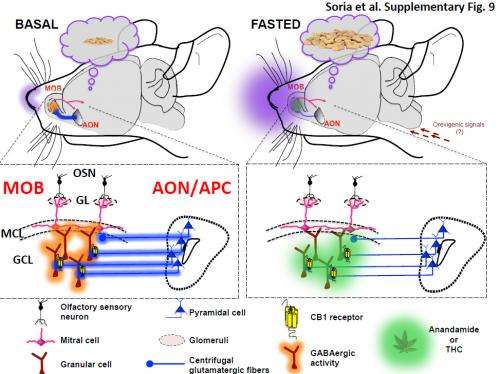Brain mechanism connecting sense of smell with appetite discovered

In a state of hunger or fasting, the increase in food intake that takes place after smelling food is linked to a type 1 cannabinoid receptor in the olfactory bulb, according to a study co-led by a UPV/EHU researcher and published today in the journal Nature Neuroscience.The work also shows that these receptors could also be a pharmacological target for the treatment of eating disorders, like those which lead to obesity or anorexia.
It is normal for the internal state of the organism to affect sensory perception, and therefore, to cause certain behaviour.One of the most well-known examples in these processes is the capacity of hunger to increase the sense of smell, and the search for and intake of food.However, until now the brain mechanism governing the connection between hunger, the sense of smell and food intake was unknown. A study conducted by an international group of researchers, including some from the UPV/EHU's department of Neurosciences, have unraveled the keys in this connection.
Before this study was carried out, the cannabinoid system was known to be linked to these phenomena."The level of endogenous cannabinoids in mammal brains is known to be increased by abstaining from food, or fasting, and the cannabinoid system is known to be an important component in regulating energy balance," explained PrdroGrandes, a researcher in the UPV/EHU's department of Neurosciences, and co-leader of the research together with Giovanni Marsicano, a researcher at the University of Bordeaux.
Endogenous cannabinoids are lipids produced on demand as a result of neuronal activity—in other words, in situations in which the system is specifically activated. The researchers who have conducted this study on mice have discovered the type of endogenous cannabinoid involved in these processes, the place where it acts, and the effect that is unleashed. Grandes explains it thus: "In situations of hunger, anandamide, which is a specific type of endogenous cannabinoid, is synthesised and acts on a specific receptor, CB1.These receptors are located at certain nerve endings in the olfactory bulb, whose function is to regulate excitatory synaptic transmission. When cannabinoids act on these CB1 receptors in the bulb, a reduction in the excitatory communication coming from olfactory areas in the cerebral cortex takes place, which ends in the innermost layer of the olfactory bulb. As a result, all the intrinsic functions that are on the level of the olfactory bulb are enhanced. So, for example, the cells that pick up smell transmit better, and therefore, the perception of smell is greater."
Experiments with mutant mice
This study has been conducted over a period of four years, so the discoveries have been gradually forthcoming. Initially, the researchers determined the distribution of the CB1 receptor in the brain. In this step, they were able to relate the location of the CB1 receptors in the excitatory endings.
Then they characterised the function of the CB1 receptor in the mechanisms described: during a state of hunger; in sense of smell perception; and in food intake."We saw that the CB1 receptor is necessary in these mechanisms, since if it was pharmacologically blocked, or if it was eliminated genetically (by producing mice lacking it), the mice ate less when they were in a state of hunger," says Grandes.
Later on, they corroborated this function of the CB1 receptor in mice that did not have this receptor, but which had been made to express it "by means of various gene manipulations," explains the researcher. "In these experiments the mice were found to eat more again when they displayed CB1 receptors in the neuronal pathway described, which projects from the cerebral cortex to the olfactory bulb." At the same time, by means of in vivo studies, the role of the CB1 receptor was confirmed in the mechanism that leads to increased food intake in the mouse.
Finally, the researchers were able to observe that these phenomena are not unleashed by the endogenous cannabinoids alone—in other words, those produced by the organism itself. "One type of exogenous cannabinoid, THC, which is the psychoactive component of cannabis, also led to the increase in the perception of the sense of smell and appetite when injected into these mice. Of course this effect always takes place in fasting conditions; in the cases in which the mice had eaten their fill, this mechanism did not kick in," says the UPV/EHU researcher.
Translating this study to the clinical sphere could lead to the production of new drugs that could be useful for treating certain eating disorders. "In people with anorexia, we could stimulate intake by enhancing these mechanisms. And by contrast, in cases of obesity, the aim would be to try and reduce the function of these CB1 receptors to reduce the perception of smell and thus get these individuals to eat less when they are hungry."
More information: E. Soria-Gómez, L. Bellocchio, L. Reguero, G. Lepousez, C. Martin, M. Bendahmane, S. Ruehle, F. Remmers, T. Desprez, I. Matias, T. Wiesner, A. Cannich, A. Nissant, A. Wadleigh, H. C. Pape, A. P. Chiarlone, C. Quarta, D. Verrier, P. Vincent, F. Massa, B. Lutz, M. Guzmán, H. Gurden, G. Ferreira, P. M Lledo, P. Grandes, G. Marsicano. 2014. "The endocannabinoid system controls food intake via olfactory processes".Nature Neuroscience.DOI: 10.1038/nn.3647

















